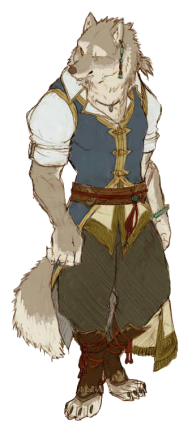Difference between revisions of "Lycanthrope"
| Line 12: | Line 12: | ||
|family=Canidae | |family=Canidae | ||
|subfamily=Caninae | |subfamily=Caninae | ||
| − | |tribe= | + | |tribe=Lycanthropini |
|genus=Lycanthropus | |genus=Lycanthropus | ||
|species=L. vocalis | |species=L. vocalis | ||
Revision as of 18:01, 21 February 2011
Lycanthropes, also known colloquially as werewolves and taxonomically as Lycanthropus vocalis, "speaking wolf-man", are large, bipedal canines indigenous to northern Cefnor. They are the only living species in the genus Lycanthropus.
Biology
Lycanthropes have large, powerful builds, with thick necks and muzzles, broad shoulders and large paws. These features are less pronounced for females, who typically have thinner necks and muzzles and smaller shoulders and paws than their male counterparts. The sexes also differ in overall size, with males being on average taller and heavier. At adulthood, male lycanthropes average 2 meters in height and 125 kilograms while females average 1.8 meters and 90 kilograms.
Locomotion for lycanthropes is bipedal and digitigrade. They use only their rear paws as feet and walk only on the digits of their feet. Only four of the foot's five digits are used in locomotion, as the innermost digit is a vestigial dewclaw. The front paws meanwhile are used as hands to manipulate objects. These hands also have five digits each, but the innermost of these is a functional opposable thumb rather than a dewclaw. These thumbs afford lycanthropes great manual dexterity. Both the hands and feet are covered in pads, located at the extremities of the digits and in the center of the paw, which provide both cushioning and traction, and all digits terminate in a nonprotractile claw.
A thick coat of fur covers lycanthropes and serves to insulate them. This coat is thickest around the head, neck and upper body, especially for males. The coat's thickness also varies with the seasons. During colder seasons the coat thickens to form a winter coat, which is subsequently molted in the spring. The most common coloration is some mixture of black, gray, white and brown fur, usually with lighter fur along the front of the torso. Coats of only predominantly red and brown fur or black, gray and white fur are also fairly common. Rare but not impossible are monochrome coats of white, black or blond. Most individual's coats will also become gray or white around the muzzle, paws and tail as they age.
At birth lycanthropes have blue eyes which in most cases are replaced by brown, yellow or orange pigmentation as the individual matures. Occasionally, however, the original blue pigmentation will persist into adulthood. Their vision is dichromatic and comparable to that of a red-green colorblind human. Their senses audition and olfaction, however, are very powerful, and the latter is the primary means by which individuals recognize one another. To this end, lycanthropes have several scent glands in their paws and at the base of the tail which allow them to be readily identified by scent.
